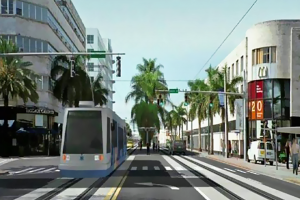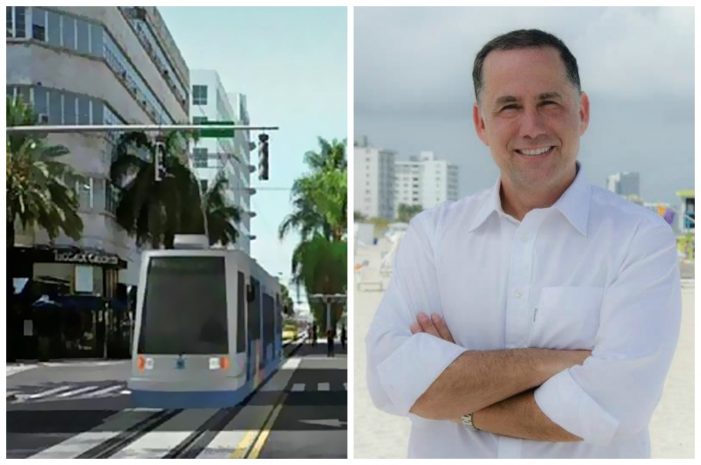The Miami Beach leg could still be the “backdoor” to a larger, more lucrative county contract
Mayor Philip Levine seems to have backpedalled some on his Loopy Loop.
Earlier this year, Levine defended his beloved train to nowhere, a stand-alone  , two-mile, $245-million streetcar that would loop from 5th Street to the convention center and eventually — maybe someday — connect to BayLink or whatever connector was finally moved on by Miami-Dade County. He was hell bent on moving independently of the county and city of Miami with an accelerated bidding process that favored the most expensive firm. He led the commission in a vote to accept the “unsolicited proposal” last December. The move was criticized by many — including Miami Mayor Tomas Regalado — because it could result in the loss of state and federal funds.
, two-mile, $245-million streetcar that would loop from 5th Street to the convention center and eventually — maybe someday — connect to BayLink or whatever connector was finally moved on by Miami-Dade County. He was hell bent on moving independently of the county and city of Miami with an accelerated bidding process that favored the most expensive firm. He led the commission in a vote to accept the “unsolicited proposal” last December. The move was criticized by many — including Miami Mayor Tomas Regalado — because it could result in the loss of state and federal funds.
Last week, however, after growing public discontent, Levine sent an email blast saying that any Beach train would only be part of a county-connecting project — one of the six corridors approved in the SMART plan is the Beach connector — and said he would hold off on final negotiations.
Read related story: Forum on controversial Beach ‘train to nowhere’
“We will not sign any agreement that commits financial resources to the plan until we have full commitments from Miami-Dade County that they are willing partners in this endeavor and that they are fully committed to a real connection,” he wrote. “This is instrumental, as our taxpayers alone should not bear the full responsibility of building a rail corridor that connects Miami Beach to the City of Miami. But, we know that for it to be a successful system, connectivity throughout Miami Beach and key points in Miami are essential.
“We cannot allow ‘grandstanding’ for political ‘points’ to slow down the progress that we’ve made. This is why my commitment to you remains unchanged. I will ensure that a transparent process through open dialogue continues and that ZERO tax dollars are committed until we have the full support from our local, state and federal partners and then and ONLY then will this vision be brought back to the commission for their consideration.”
Instead of a vote on any agreement, Levine is now presenting a resolution to the commission Wednesday that puts the brakes on the Loopy Loop and also calls for a voter referendum to approve any final contract.
But this about face doesn’t come out of the blue. Levine can read poll results.
Some voters in Miami Beach received a phone call for a poll earlier this month. They were asked between 10 and 15 questions about the train before they were asked the favorability of several Beach politcos (more on that later). It was an obvious push poll, two residents said, with each question placing the train “in the best possible light.” But we know it didn’t work.  Because the result is that Levine is now backing off.
Because the result is that Levine is now backing off.
But not really.
The resolution Levine is putting before the commission on Wednesday will only put negotiations on hold. It doesn’t scrap the project to start the process again. It doesn’t throw the train out altogether. It simply “parks” the negotiations until the county moves forward with its part of the formula — or until after the elections next year, whichever comes first.
Because Levine doesn’t want the train to be a campaign issue. If what we’ve seen at public meetings is true, Ladra  imagines it polled very badly. Candidates attached to the train — such as Levine or Commissioner Ricky Arriola, who is widely believed would stand in for the mayor should Levine seek higher office — could be more easily challenged with that albatross around their necks. Especially by someone like Comissioner Michael Grieco, pictured left, who is widely rumored to be eyeing the mayor’s seat (more on that later) and whose profile has been growing as he distances himself from his onetime ally. Grieco blasted the mayor for inviting the Cuban government to open a consular office in Miami Beach. And last week, Grieco blasted the train to nowhere in an op-ed piece in The Miami Herald. In fact, he’s not even sure that a train is needed at all, even as part of a BayLink.
imagines it polled very badly. Candidates attached to the train — such as Levine or Commissioner Ricky Arriola, who is widely believed would stand in for the mayor should Levine seek higher office — could be more easily challenged with that albatross around their necks. Especially by someone like Comissioner Michael Grieco, pictured left, who is widely rumored to be eyeing the mayor’s seat (more on that later) and whose profile has been growing as he distances himself from his onetime ally. Grieco blasted the mayor for inviting the Cuban government to open a consular office in Miami Beach. And last week, Grieco blasted the train to nowhere in an op-ed piece in The Miami Herald. In fact, he’s not even sure that a train is needed at all, even as part of a BayLink.
So, Levine slowing down on the train track is not him coming to his senses, folks. It’s strategic. And the mayor has every intention of bringing the wireless light rail streetcar back.
He owes it to Alex Heckler, pictured right, a lobbyist who has raised money for him and who represents the Greater Miami Tramlink Partners led by Alstom, the troubled vendor chosen after a trip to France. Heckler also raised money for Miami-Dade Mayor Carlos Gimenez with Levine in the last election cycle. Why is Gimenez important in this story? For the same reason the streetcar is coming back: Because this Miami Beach deal is a back door to the county part of this project, which will cost millions more. If the Beach branch of the BayLink connector is already in the works when the county awards its own contract, points can be awarded to the contractor who has “shovels in the ground” and/or the county can piggy back on the existing contract, advocating for the same system to be used throughout because this vendor — who might otherwise be the least qualified and most expensive — has a unique criteria that the others don’t: They are already here.
Read related story: Uber as public transit is a bad, temporary bandaid
Plus, guess what? The Alstom systems are not interoperable with others. They have some kind of proprietary secret GPS mechanism that they don’t share with other operators either. So, doesn’t that mean that if they get the Beach contract, they would have to get the county contract if we want them to work together? Sure sounds like it.
In fact, there are all kinds of red flags on the selection or recommendation of Tramlink/Alstom that perhaps should be investigated. In a bid protest letter sent to City Manager Jimmy Morales in July, Mark Stempler, an attorney representing a competing proposal from Connect Miami Beach, says that the Tramlink Partners plan should not have been given top ranking because it deviates from the Beach’s own procurement requirements in several ways:
- It fails to satisfy a “critical requirement that the proposed “Vehicle/Systems Technology” will be interoperable with the Direct Connect Project (read: no guarantee it can connect to the mainland branch).
- It fails to demonstrate that it could even deliver, based on the fact that the proposed streetcars and ground power supply systems that Alstom has used in Europe have NOT been certified to operate in the U.S.
- It fails to meet the city’s stated standards for “character, integrity, reputation or judgment,” based on the City’s finding of “prior admissions of misconduct” by one of the GMTP team members stemming from bribery and corruption charges, including the payment of a then-record $772 million dollar fine to the U.S. Government.
The gist is that these irregularities in applying the same standards to all gave Tramlink Partners and Alstom a greater advantage. Especially with the character flaw one. Because unproven corruption allegations were noted in the case of partners with Connect Miami Beach — but the proven charges against Alstom seemed to be okay.
In fact, the city may be wiser to go with Connect Miami Beach, the second ranked firm. Particularly after they pointed out last week, in a Dec. 7 letter to Morales, that the $245-million pricetag is much higher than the price on its comparable projects — at $107 million per mile rather than the $45-$55 million per mile quoted for projects in Cincinnatti, Kansas and Milwaukee.
That’s twice as expensive. Is it because of Mr. Heckler’s fee? Or are there other people getting paid off along the route?


